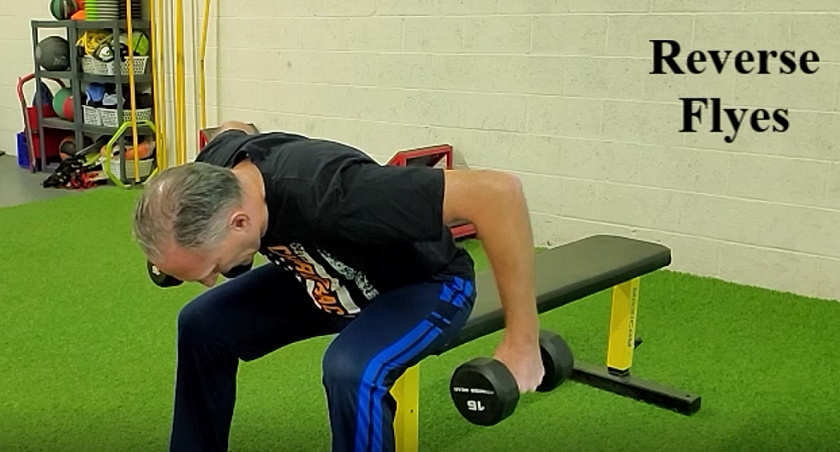Perform reverse dumbbell flyes to strengthen the posterior shoulder, rotator cuff and upper back to improve posture and shoulder function. Reverse flyes help to build proportional shoulder strength. Reverse dumbbell flyes develop several key muscles in the posterior shoulder.
Reverse flyes primarily target the posterior head of the deltoid muscle. Reverse dumbbell flyes also train the supraspinatus, infraspinatus and teres minor. These three muscles compose the posterior aspect of the rotator cuff. Reverse dumbbell flyes also build the muscles in the upper back that retract the shoulder blades.
Anatomy: The posterior aspect of the deltoid muscle originates on the scapula and merges with the fibers of the anterior and lateral sections of the deltoid to attach to the upper arm bone. When contracted the posterior deltoid pulls the upper arm backward toward the spine.
The supraspinatus, infraspinatus and teres minor muscles originate on the posterior side of the shoulder blade and attach to the upper arm. As a unit they contract to raise the upper arm and externally rotate the upper arm.
The muscles that originate on the spine and attach to the shoulder blades are the rhomboid major, rhomboid minor and the middle and inferior aspects of the trapezius. These important muscles retract the shoulder blades toward the spine. Collectively they are known as the scapular retractors.
Posture and Function: The correct balance of strength between the muscles that pull the shoulder backward and the muscles that pull the shoulder forward are necessary for proper posture and correct functional movement. Proportional strength is imperative for healthy shoulder performance.
Technique: Correct technique is vital and more important than the amount of weight. Start light and perfect your technique before increasing resistance.
Reverse dumbbell flyes can be performed seated, standing or prone on an incline bench. If seated or standing hinge forward at the hips to about ninety degrees. Grasp a dumbbell in each hand with your wrists straight, elbows bent and upper arms ninety degrees from the trunk. Begin with the weights close to the floor and almost touching each other.
Retract your scapulae. Maintain scapular retraction through the entire set. Exhale and raise your shoulders and arms backward at ninety-degree angles from the body. Keep your elbows bent and lift your shoulders as high as you can. Inhale and lower the dumbbells in a controlled manner.
Reverse dumbbell flyes are best performed after the basic multi-joint exercises. Begin with one set of ten to thirty repetitions. If needed, add a second and third set in gradual increments. Progress in weight slowly and feel the correct muscles working throughout the exercise.
Utilize reverse dumbbell flyes to strengthen your posterior shoulders. Strength and endurance in the posterior shoulder improves upper body posture and shoulder function.
Dr Donald A Ozello DC of Championship Chiropractic in Las Vegas, NV
Web Site: http://www.championshipchiropractic.com/
Blog: https://www.championshipchiropractic.com/wordpress/
YouTube: https://www.youtube.com/user/drdozellodc/videos
Twitter: https://twitter.com/drdozellodc
Facebook: https://www.facebook.com/Championship-Chiropractic-280141628688300/
LinkedIn: https://www.linkedin.com/in/dr-donald-a-ozello-dc-716b3233
“Running: Maximize Performance & Minimize Injuries” https://www.amazon.com/Running-Performance-Chiropractors-Minimizing-Potential/dp/1493618741
**Disclaimer: Always consult a medical professional before beginning an exercise program. Always work within your capabilities. Never perform an exercise that elicits or increases pain or symptoms. Reading this article and viewing the linked videos does not take the place of seeing a medical professional. Please visit a medical professional for evaluation, diagnosis & treatment.

